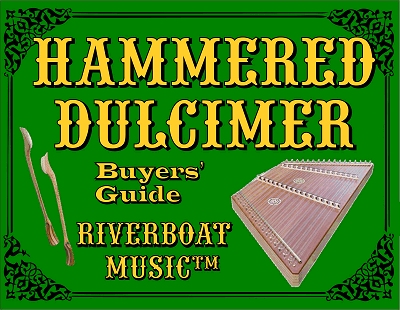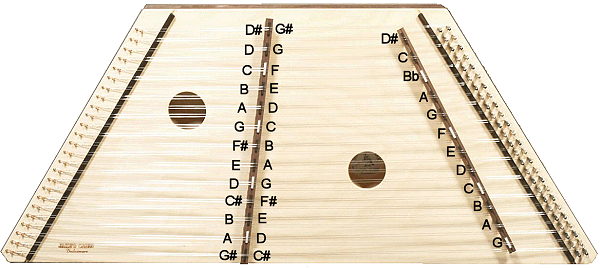 | |||
 |
5-string - 6-string - 4-string Others - Accessories |
||
Dreadnoughts - Archtops Classical - Parlor Starter - Jumbo - Tenor |
|||
Saxophones |
|||
 | |||
 |
5-string - 6-string - 4-string Others - Accessories |
||
Dreadnoughts - Archtops Classical - Parlor Starter - Jumbo - Tenor |
|||
Saxophones |
|||
Written by Paul D. Race for
 , ,  , and , and  |
|
Buyer's Guide for Hammered Dulcimer - From Riverboat Music(tm), Unlike most of the other instruments featured on this site, the hammered dulcimer has not been supported by many major musical instrument manufacturers, so most of the ones you come across are hand-built or largely hand-built. Even a relatively "simple" hammered dulcimer requires precision, craftsmanship, and engineering skills that don't translate well to third-world manufacturing, so you seldom see one that is imported. But potential students don't really suffer from the lack of cheap instruments that are more likely to discourage than delight. The fact is that US-built student models are available for a reasonable price, and even professional models are reasonable by US-built stringed instrument standards. As always, I encourage you to start out looking at the used market. The hammered dulcimer I play most often (because it's so portable), is a Meadowlark, a laminated, but very sweet student instrument I got for less than half of list price from a local retiree. On our local Craig's List today, there are two hammered dulcimers, one overpriced for its age and condition, and one solid-topped, reputable model that is significantly underpriced. Now you may not have the good fortune to be living in Springfield, Ohio, but it's worth a look wherever you are. Chances are anything you buy used will need cleaned and tuned, and maybe even new strings. But if you save significant money, that's worth considering. Also, Elderly music - with whom I have no business relationship whatsoever (except as an occasional customer) frequently sells used models in various conditions. What is a Hammered Dulcimer?Related to the ancestor of the piano and harpsichord, this family of instruments has been around for millennia. Modern hammered dulcimers are tuned so that you can easily play them in typical folk keys. The things have two long bridges and usually 23 or more pairs of string stretched across them in such a way that you can play notes by tapping each pair of strings (called a "course") near the bridges.You can't play a scale just by going up one side of the bridge all the way, as the key of the instrument actually changes as you go "north." Instead you play part of the scale on one bridge, and finish it up on the next bridge to your left. To show you what I mean, I've drawn up a note chart for a 13/12 student dulcimer - the Jake's Cabin Meadowlark.  As an example, to play a G scale, you could start on the G in the lower right hand corner. When you get up to C, you start over again by jumping to the D near the bottom of the middle course and going back up. You can play D scale by starting on the D near the bottom in the middle. When you get to G, you go back to the A that is just to the left of the D you started on, and so on. They tell me that once you get in the habit of playing scales this way, the rest is pretty easy. At my age, I can play with it for an hour and really make progress, but the next day I have to start all over again. Maybe if I'd started younger . . . I can tell that knowing the Circle of Fifths will be a big boost to anyone trying to get their head around it. Structural OptionsYou can see that 23 pairs of strings (minimum) means that there are at least 46 tightly-wound metal wires being stretched between the two ends of the thing. Some larger dulcimers that have three strings per course and more courses approach 100 strings - more than a piano. In other words, there's a lot of pressure on the frame and on a face that still has to be thin enough to resonate and project sound. That's where the engineering comes in, and why quality of materials is critical. Laminated or Solid Top - The Jake's Cabin Meadowlark shown above uses a laminated top. It does make the thing a little quieter than the solid-topped instruments, but that's not necessarily a bad thing when you're first learning. (In fact, if you live in an apartment building or dorm, a laminated (plywood) top dulcimer might be your first choice. The next model up - the Wren - uses a solid Spanish cedar face. Other instruments use Sitka spruce (the same material used in top-line guitars) or other woods. A well-designed top with great wood increases volume and sustain, which is why some top-of the line hammered dulcimers create such a wall of sound. Number of Courses - In addition to material and structural choices, dulcimers vary in the number of courses. If you look at the picture above, you'll see that 12 courses of string cross the bridge on the right, while 13 courses cross the bridge on the left. So this is called a 13/12 dulcimer. Some company's entry level are 12/11, and some companies make dulcimers up to 17/16. Usually those extra notes are at the lower end of the range. That makes it easier to play songs in A, but, because those longer strings require the dulcimer to be wider, they usually make the thing heavier and more unwieldy. If you're just beginning, you may be happy with a 13/12 or 12/11. For one thing, they're a lot easier to cart around. Construction - since there aren't many third-world hammered dulcimers on the market, you can count on most of the ones you come across being pretty solid. What you can't see in photos is that the frame underneath the soundboard includes two hefty hardwood end pieces ("pin blocks") for holding the pins and tuning pegs, There are also long hardwood braces under the treble and bass bridges to keep the strings from collapsing the soundboard (not shown). The bottom of the dulcimer can be laminate or solid wood - any difference in tone is negligible, and most folks prefer the stability of laminate. Here's an irony - the hammered dulcimer is closely related to several similar instruments used in the Middle East. So the Pakistani-made Roosebeck 16/15 Buying NewIf the used market doesn't pan out, you can track down authentic, well-made instruments from regional craftsmen. To find a builder near you, try the following link on the Everything Dulcimer Mountain Dulcimer Builders Search Page:A friend reminded me that many dulcimer-builders take their ware to festivals, where folks can try them out. In fact folks who can't play can usually find someone who can, so they can compare the sound. To find festivals near you, try the following link on the Everything Dulcimer Mountain Dulcimer Builders Search Page: ExamplesIn the meantime, to help you get an idea of the kinds of instruments available, I have put together a little table that starts with a good (relatively portable) student instrument and moves onto some BIG HONKING DULCIMERS. :-) The list is by no means exhaustive - it's just meant to show you some of the range of instruments available. Hopefully this information will get you familiar enough with this class of instruments to be able to decide which one will best suit your needs.
Sticking With ItBy the way, lots of folks buy Hammered Dulcimers when they're in the mountains because they're cool and not THAT expensive, considering. Then they get them home and never learn how to play them. If you're going make this investment, plan on making investments of time every week to work with the thing. And the best thing you can do is find other likeminded people to learn from, encourage, and generally hang with.The Everything Dulcimer page includes a search feature to find regional dulcimer clubs. Click the following link to get there: True, some of those clubs are mostly for other instruments or only have one or two hammered dulcimer players involved. Don't give up until you find folks who'll encourage you and challenge you when you need it. ConclusionHowever you chose to acquire the instrument coming into your household, we wish you the best, and we'll answer your questions if we can. Note about Suppliers: While we try to help you get the instruments and other products you want by recommending suppliers with a good record of customer service, all transactions between you and the supplier you chose are governed by the published policies on the supplier's web site. So please print off any order confirmation screens and save copies of invoices, etc., so you can contact the appropriate supplier or invoke the product warranty should any problems occur.* Note about Availability and Pricing: Although I try to keep an eye on things and to recommend products that are reasonably available, the musical instrument market does fluctuate, and any product on this page may change price or become unavailable without prior notice. If you "click through" to see details on a product, and nothing happens at all, or you are routed to a supplier's home page, please let me know and I will remove the product from the online listing until I can find a replacement or another supplier. *Here's an irony: every year, I receive about a dozen complaints from folks who have never been to my sites before, angry that a deal between that person and a vendor or manufacturer I recommend went south (in their opinion). They "googled" the product, saw my recommendation or review, then e-mailed me to tell me they were going to sue me or report me to the Better Business Bureau for personally ripping them off by recommending a product they had bought from someone else. Ninety-nine times out of a hundred, the problem is really because the customer didn't read the whole ad, or ordered the wrong thing, or threw away his paperwork and doesn't know whom he bought it from, etc. I'm always polite, and sometimes I can even help them get things straightened out with the vendor, but it's not, technically, my problem. Click here to return to the text.
|  |
|||||||||||||||||||||||||||||
| Visit related pages and affiliated sites: | ||||||
| - Music - | ||||||

|
 |
 |

|

|

|
|

|

|

|

|

|

|
|
| - Trains and Hobbies - | ||||||
 |

|

|  |
 |

|
|
| - Christmas Memories and Collectibles - | ||||||
 |

|
 |

|
 |

|
|
| - Family Activities and Crafts - | ||||||
 |

|

|

|

|

|
|